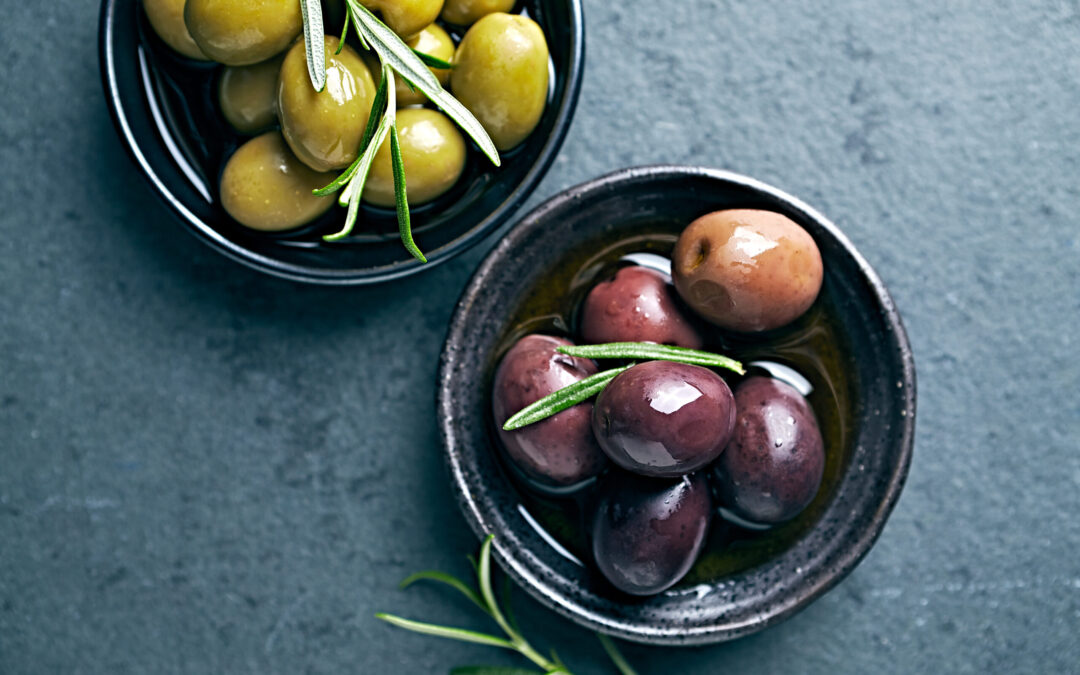If you’ve ever strolled through your local supermarket, chances are that you’ve seen an olive bar in the store. Black, green, purple, pitted, stuffed…The large variety of olives may intimidate you, but after reading this, you’ll learn about the different types of olives and a few dishes that they pair well with.
Ancient Greeks considered the olive tree as a gift from the gods. Although they originally were used only in many Mediterranean dishes, Olives and olive oil are currently featured in thousands of other dishes. There’s no such thing as a bad olive, but some may taste better than others, depending on your palate. Olives are universal and can be used in virtually any meal and in some beverages. Some olives may taste sweet, while others taste sour or salty. They can be tossed into salads, grounded into spreads and tapenades, simmered in stews and sauces, eaten alone by hand as a snack, or even plopped into martinis as a garnish.
Olives get their taste and appearance from where they were grown, such as geographical region and climate. Factors that also play a huge part are how they were harvested and cured. Additionally, the different ways of marinating, seasoning, and stuffing the olives determine their flavor and texture. While there are up to 27 different types internationally, here are a few of the most common olives used today.
Castelvetrano
Italy’s most common olives are Castelvetranos. Native to Sicily, they have a bright green, buttery flesh, and a mild flavor. They are sometimes pitted and stuffed with pimento, garlic or jalapeno. Consider serving them with Fontinella cheese and white wine, like Zinfandel.
Cerignola
These long green olives are harvested in Italy’s Puglia region. They are crisp and buttery. Their size makes them easily stuffable. They go well with garlic, cheese, capers, and anchovies.
Cracked Green Olive
Sometimes known as Tsakistes, these green olives are large and firm with cracked flesh. They marinate in oil mixed with herbs, garlic, lemon, onion or fennel. Their sharp flavor pairs nicely with cheese. Try them in potato or bean salads.
Kalamata
Kalamatas are deep purple, with tight, shiny skin, and an almond shape. They’re typically preserved in red wine vinegar, red wine, and/or olive oil. Use these salty, pungent olives in a Greek salad with Feta, olive bread, pizza, or puttanesca sauce.
Liguria
Liguria, also called Taggiasca olives, come from the Italian seaside town of Liguria near the French border. These small, black olives are brine cured with bay leaves, rosemary, and thyme. Liguria olives are vibrantly flavorful. To give your tastebuds a treat, try adding them on pizza or your favorite fish dish.
Manzanilla
Manzanilla, also known as Spanish Olive, is originally from the Andalusia region of Spain, but is also grown in California. These small to medium green olives have a smoky flavor. They are typically sold unpitted or stuffed with pimientos, almonds, anchovies, jalapenos, onions or capers. For the perfect flavor, use Manzanilla’s in your favorite chicken or fish dish.
Nyon
These tiny black olives with prune-like skin come from Southern France. Nyon olives are dry cured and aged in brine. They have a slightly bitter taste and go well with herbs like rosemary and thyme.
Nicoise
These brown or black olives have a licorice-like taste. They are grown in the Southeastern region of France, as well as in Italy and Morocco. Nicoise olives are cured in brine and packed in olive oil. They go well with tuna in a Salad Nicoise, or cheese, bread and wine.
Picholine
These long and slender Green olives are from Provence, France and have a crunchy texture. They are either mild, or tart and juicy, depending upon how they get brined. Add them for a punch to risotto or a hearty stew.
Sevillano
Sevillano’s come from Seville, Spain. These green olives are large, round, salt-brine cured with a bit of lemon and bay leaf. Pair Sevillano olives with Feta or Goat Cheese.

